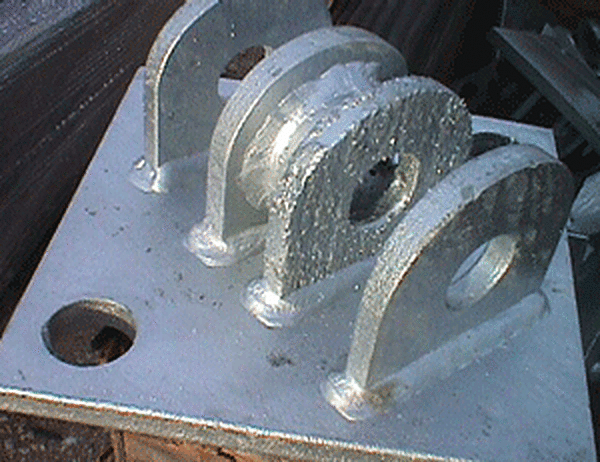Steel Surfaces

Surface preparation is essential in order to ensure a top-quality galvanized coating. Steel must be entirely clean for the metallurgical reaction between it and molten zinc to occur and the galvanized coating to form.
Common residues found on steel, rough surfaces, heat-treating-induced surface coatings, rust, and other surface contaminants need to be removed prior to galvanizing, as they may prevent the formation of a consistent and uniform zinc coating.
It is important to understand:
- Rough steel surfaces created during fabrication or abrasive cleaning processes may cause thicker zinc coatings
- Casting surfaces should avoid sharp corners and deep recesses, use large pattern numerals and generous radii to facilitate abrasive cleaning (necessary to remove sand that inhibits zinc adhesion), and have uniform wall sections. Non-uniform wall thickness in certain casting designs may lead to distortion and/or cracking. Cracking results from stress developed as the temperature of the casting is increased during galvanizing. Uniform wall sections and a balanced design lowers stress.
- Heat-treating steel often must be blast cleaned because it introduces a surface coating not removed by conventional chemical cleaning processes.
- Steel surfaces that have varying degrees of rusting require varying amounts of time in the cleaning stages of the galvanizing process, resulting in a variety of surface finishes.
- Minimize the use of cutting oil when planning to galvanize. If cutting oil use is unavoidable, consult the galvanizer to determine if normal chemical cleaning processes will remove it or another means of removal is necessary.
- Welding slag adhered to the steel surface must be removed prior to galvanizing.
- Welding slag adhered directly onto the weld is easily removed by grinding
- Welding slag adhered around the weld areas is more difficult to remove and usually cannot be ground away; other means of mechanical removal, such as blasting, must be used to remove it.
When welding, flux and molten metal particles (weld slag) may splatter and adhere to the steel. Although this is common when welding steel, these particles must be removed prior to galvanizing. The standard chemical cleaning used in the galvanizing process do not remove welding slag. Additionally, if welding slag particles are carried over to the zinc bath, they will cause coating defects and areas that may have compromised corrosion prorection.
